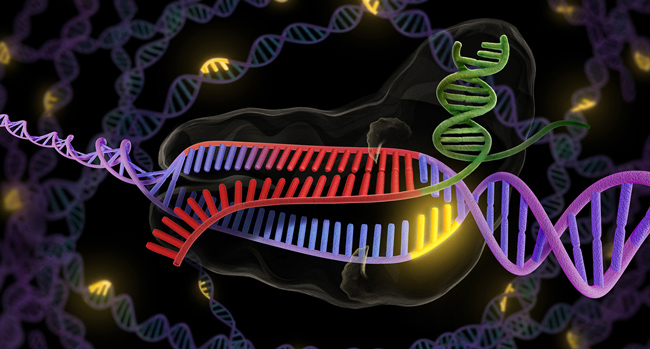MCB TRANSCRIPT

Genome Editing: A Simple Way to Cut and Paste DNA
In 2012, MCB Professor Jennifer Doudna made a chance discovery that for the first time made it easy to edit DNA at will. “It began as a curiosity driven project,” she says. “It’s a triumph of basic science.” Today, biologists around the world use her technique to add, snip out, or replace genes in plants, animals and human cells. Her discovery could accelerate molecular biology research worldwide, and hasten therapies for illnesses from cancer to Huntington’s disease.

It all started a decade ago, when Doudna wanted to know how a type of bacterium protects itself against viruses. She found that the bacteria co-opt a bit of viral DNA, cutting and pasting it into their own DNA. Then the next time a virus tries to invade, the bacteria turn that saved bit of DNA against it. The saved viral DNA makes a piece of RNA, which in turn guides an enzyme called Cas9 to the matching DNA in the virus — and Cas9 snips out that DNA, thus disabling the virus.
Unlike previous gene editing techniques, Doudna’s elegant technique — called CRISPR/Cas9 — is accessible to anyone with basic molecular biology skills. All you need is an RNA that will guide the enzyme to the DNA site you want to cut. “It’s very democratic,” Doudna says. “You don’t need any special equipment or training, and it’s not expensive.” Applications range from correcting mutations in cells to engineering disease resistance in plants.
To help us get the most out of her new genome editing technique, Doudna co-founded the Innovative Genomics Initiative, which celebrated its grand opening in February 2015. Based at UC Berkeley and in collaboration with UCSF, the IGI’s goal is to boost clinicians’ access to CRISPR/Cas9. “We are joining basic science with medical experts to use the technology to advance human health,” she says, adding that immune system diseases are an initial focus.
Doudna also continues to explore CRISPR/Cas9 in her own lab. Projects include understanding how the system works at the molecular level, which could help researchers edit DNA with even greater precision, as well as using the system to treat diseases. “We’re working to repair the mutation in Huntington’s disease, and to reprogram immune cells so they fight cancer,” she says.
Doudna enjoys being at the intersection of basic science and medical research. “It’s very cool to interact with applied clinical labs,” she says. “I think this kind of collaboration will lead to the biggest advances in human health.”
In recognition of her work, Doudna has recently received these honors and awards: Dr. Paul Janssen Award for Biomedical Research (2014), Fellow of the National Academy of Inventors (2014), Foreign Policy's 100 Leading Global Thinkers (2014), Lurie Prize in the Biomedical Sciences (2014), MIT Technology Review's Ten Breakthrough Technologies (2014), Breakthrough Prize in Life Sciences (2015), Princess of Asturias Award (2015), Gruber Genetics Prize (2015).





